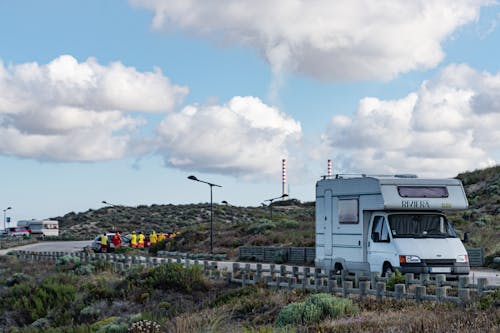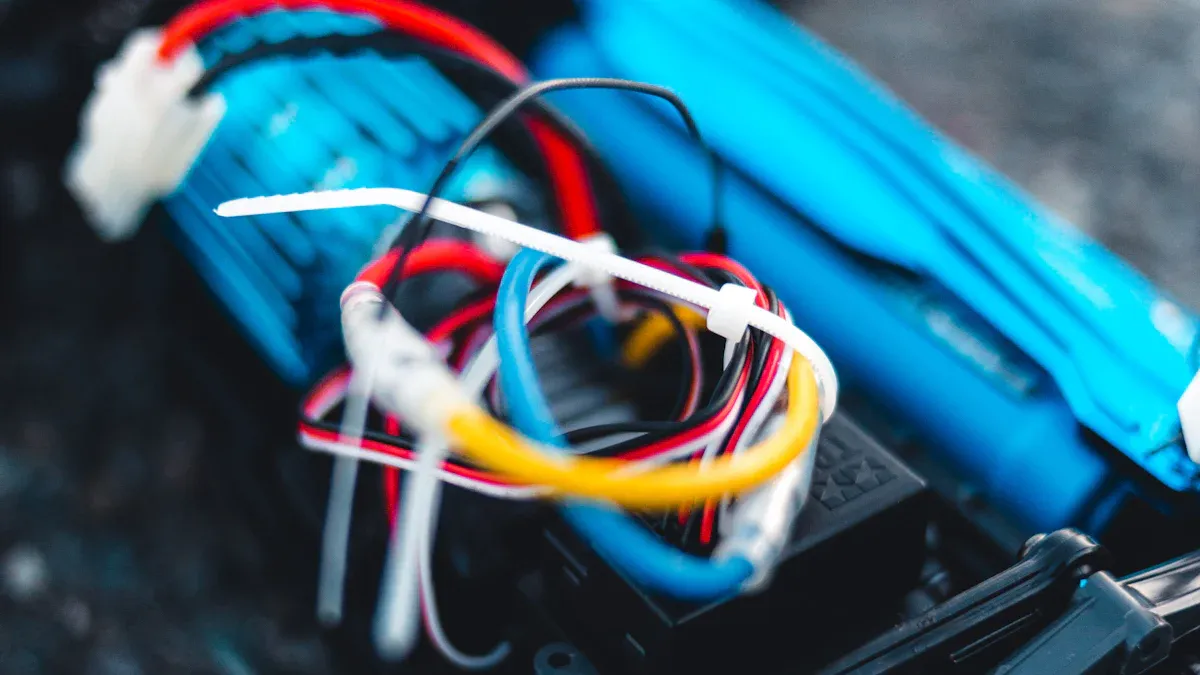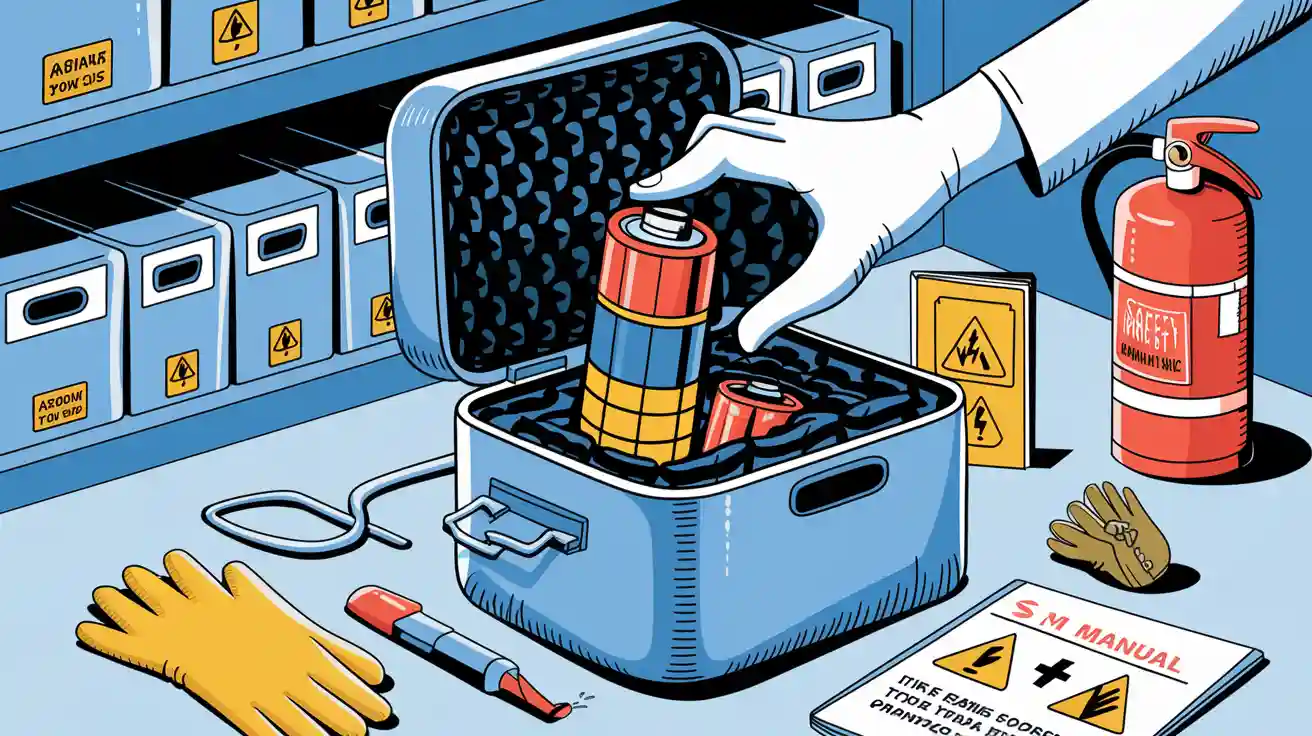Contents

High cycle life batteries play a critical role in powering RVs and marine vessels. They ensure reliable energy storage, which is essential for off-grid adventures and extended marine trips. Choosing the right battery can significantly enhance your experience by reducing downtime and maintenance.
LiFePO4 batteries, with a cycle life of 3,000–5,000 cycles, outperform lead-acid batteries, which last only 200–500 cycles.
Although LiFePO4 batteries cost more initially, their longer lifespan and minimal maintenance reduce overall expenses. Over five years, they prove more cost-effective than lead-acid alternatives.
By investing in a high cycle life battery, you can enjoy uninterrupted power and long-term savings.
Understanding Battery Types for High Cycle Life

Lead-Acid Batteries
Pros and cons of lead-acid batteries
Lead-acid batteries are a traditional choice for energy storage. They are affordable and widely available, making them a popular option for budget-conscious users. Flooded lead-acid batteries offer the lowest upfront cost, while AGM (Absorbent Glass Mat) and gel variants provide better safety and performance. However, lead-acid batteries have significant drawbacks. They are heavy, require regular maintenance, and have a limited cycle life of 200–500 cycles. Additionally, they emit hydrogen gas during charging, which can pose safety risks in enclosed spaces.
Battery Type | Advantages | Disadvantages |
|---|---|---|
Flooded Lead-Acid | Affordable, widely available | Heavy, requires maintenance, emits gas |
AGM Lead-Acid | Spill-proof, vibration-resistant | More expensive, still heavy |
Gel Lead-Acid | Good for slow discharge | Sensitive to overcharging |
Suitability for RVs and marine use
Lead-acid batteries can work for RVs and marine applications if cost is a primary concern. However, their weight and maintenance needs make them less ideal for off-grid adventures. AGM batteries, a type of lead-acid battery, are better suited for these environments due to their spill-proof design and vibration resistance.
AGM (Absorbent Glass Mat) Batteries
Features and benefits of AGM batteries
AGM batteries are an advanced type of lead-acid battery. They are sealed, spill-proof, and require minimal maintenance. Their ability to handle vibrations makes them ideal for RVs and boats. AGM batteries also perform well in off-grid scenarios, powering essential appliances like refrigerators and lights.
Key benefits of AGM batteries:
Spill-proof design ensures safety in mobile environments.
Vibration resistance enhances durability during travel.
Minimal maintenance compared to flooded lead-acid batteries.
Cycle life and performance in off-grid applications
AGM batteries offer a cycle life of 400–600 cycles, which is higher than traditional lead-acid batteries. While they are heavier and less efficient than lithium-ion batteries, they provide reliable power for short-term off-grid use. For example, they can sustain essential appliances during weekend camping trips or short marine excursions.
Lithium-Ion Batteries
Why lithium batteries are ideal for high cycle life
Lithium-ion batteries, particularly LiFePO4 batteries, are the gold standard for high cycle life applications. They deliver 2,000–5,000 cycles, far surpassing lead-acid and AGM batteries. Their lightweight design and high energy density make them perfect for RVs and marine vessels, where space and weight are critical factors.
Key advantages over traditional battery types
Lithium-ion batteries charge faster and operate efficiently in extreme temperatures. They also maintain stable performance in high-humidity marine environments. Unlike lead-acid batteries, they require no maintenance and have excellent thermal stability, ensuring safety during operation.
Metric | LiFePO4 Battery | Lead-Acid Battery |
|---|---|---|
Cycle Life | 2,000–5,000 cycles | 200–500 cycles |
Charging Efficiency | High (Fast Charging) | Low (Slow Charging) |
Environmental Adaptability | Excellent (Extreme Temperatures) | Poor (Cold Weather Decline) |
Lithium-ion batteries are the best choice for long-term off-grid adventures. A 200Ah LiFePO4 battery pack can power an RV for over three days, while lead-acid batteries last only about a day.
Emerging Battery Technologies
Overview of LiFePO4 Batteries and Their Benefits
LiFePO4 (Lithium Iron Phosphate) batteries represent a breakthrough in energy storage for RVs and marine applications. These batteries are engineered to deliver exceptional performance, making them a reliable choice for off-grid adventures. You can count on their long lifespan, which ranges from 2,000 to 5,000 cycles, far exceeding traditional battery technologies.
LiFePO4 batteries excel in several key areas:
Energy Density: They store more energy in a compact size, saving valuable space in your RV or boat.
Cycle Life: Their extended lifespan reduces the need for frequent replacements, offering long-term cost savings.
Charging Efficiency: These batteries charge faster, minimizing downtime during your trips.
Environmental Adaptability: They perform consistently in extreme temperatures and high-humidity environments.
Safety: Advanced Battery Management Systems (BMS) and thermal stability ensure safe operation, even under demanding conditions.
With these benefits, LiFePO4 batteries provide a dependable and efficient power source for your adventures.
Comparison of LiFePO4 with Lead-Acid and AGM Batteries
When comparing LiFePO4 batteries to lead-acid and AGM options, the differences are striking. LiFePO4 batteries offer superior performance in almost every category.
Feature | LiFePO4 Battery | Lead-Acid Battery | AGM Battery |
|---|---|---|---|
Cycle Life | 2,000–5,000 cycles | 200–500 cycles | 400–600 cycles |
Weight | Lightweight | Heavy | Heavy |
Maintenance | None | Regular | Minimal |
Charging Speed | Fast | Slow | Moderate |
Environmental Range | Wide (Extreme Temperatures) | Limited | Moderate |
LiFePO4 batteries outperform lead-acid and AGM batteries in durability, efficiency, and safety. Their lightweight design makes them ideal for RVs and boats, where space and weight are critical. Unlike lead-acid batteries, they require no maintenance and deliver consistent power over their lifespan. AGM batteries, while an improvement over traditional lead-acid, still fall short in cycle life and charging efficiency.
By choosing LiFePO4 batteries, you gain a reliable, long-lasting solution tailored to meet the demands of RV and marine use.
Key Factors to Consider When Choosing a High Cycle Life Battery
Battery Lifespan and Cycle Life
How to evaluate cycle life ratings
When selecting a high cycle life battery, understanding cycle life ratings is crucial. Cycle life refers to the number of charge-discharge cycles a battery can complete before its capacity drops to 80% of its original value. For example, LiFePO4 batteries typically offer 2,000–5,000 cycles, while lead-acid batteries last only 200–500 cycles.
To evaluate cycle life, consider the following metrics:
Cycle Life: Indicates longevity and cost-effectiveness.
Capacity Fade: Measures the gradual loss of battery capacity over time.
State of Health (SOH): Reflects the battery’s current performance compared to its original condition.
Metric | Definition |
|---|---|
Cycle Life | Number of charge–discharge cycles until capacity drops to 80% of nominal capacity. |
Capacity Fade | The inevitable reduction in battery capacity due to cyclic operations and electrochemical mechanisms. |
State of Health (SOH) | Current internal resistance compared to a new battery or the ratio of current capacity to initial capacity. |
Importance of depth of discharge (DoD) and charge cycles
Depth of discharge (DoD) significantly impacts battery lifespan. A lower DoD extends cycle life, as batteries experience less strain during each cycle. For instance, a LiFePO4 battery discharged to 50% DoD can last twice as long as one discharged to 80%. You should aim to match your energy needs with a battery that minimizes deep discharges.
Capacity and Power Requirements
Calculating your RV or boat’s energy needs
Accurately calculating energy needs ensures you choose the right battery capacity. Start by listing all appliances and their wattage. Use this formula to estimate daily consumption:Daily Consumption (Wh) = Wattage (W) × Hours Used Per Day
For example, if your appliances consume 1,000Wh daily, a 12V battery with 100Ah capacity (1,200Wh) would suffice for one day. Always select a battery with extra capacity to handle power spikes and emergencies.
Matching battery capacity to your usage patterns
Your battery should align with your energy usage. For extended off-grid trips, LiFePO4 batteries are ideal. They can power appliances for over three days on a single charge, unlike lead-acid batteries, which last only about a day. Consider factors like total power demand, usage time, and environmental conditions when choosing a battery.
Size and Weight Considerations
Space constraints in RVs and boats
Space is often limited in RVs and marine vessels. Lithium batteries, such as LiFePO4, offer high energy density, saving space compared to bulky lead-acid batteries. Their compact size allows for easier installation in tight compartments.
Balancing weight with performance
Weight plays a critical role in performance and fuel efficiency. Lithium batteries weigh 50–70% less than lead-acid options, making them a better choice for mobile applications. Despite their lightweight design, they deliver superior performance, with over 3,000 cycles and faster charging speeds.
Feature | Lithium Iron Phosphate (LiFePO4) | Lead-Acid |
|---|---|---|
Energy Density | High (Lightweight) | Low (Heavy) |
Cycle Life | 2,000–5,000 cycles | 200–500 cycles |
Charging Efficiency & Speed | High (Fast Charging) | Low (Slow Charging) |
Environmental Adaptability | Excellent (Handles Extreme Temperatures) | Poor (Cold Weather Decline) |
Tip: Opt for lithium batteries to reduce weight and maximize efficiency without compromising performance.
Durability and Environmental Resistance
Withstanding vibrations and water exposure in marine environments
Marine environments demand batteries that can endure constant vibrations and exposure to water. You need a battery designed to handle these challenges without compromising performance. Lithium-ion batteries, especially LiFePO4 variants, excel in this regard. Their sealed construction prevents water ingress, ensuring reliable operation even in wet conditions. Additionally, their lightweight design minimizes strain on mounting systems, reducing the risk of damage during rough seas or bumpy RV rides.
Tip: Choose batteries with vibration-resistant features and IP-rated enclosures for enhanced durability in marine applications.
Operating in extreme temperatures
Extreme temperatures can affect battery performance, especially in off-grid scenarios. High cycle life batteries like LiFePO4 maintain consistent output in temperatures ranging from -20°C to 60°C. This adaptability ensures reliable power whether you’re camping in freezing conditions or navigating tropical waters. Unlike lead-acid batteries, which lose efficiency in cold weather, LiFePO4 batteries deliver stable energy regardless of the climate.
Note: Batteries with advanced thermal stability and integrated Battery Management Systems (BMS) are ideal for extreme temperature environments.
Compatibility with RV and Marine Systems
Ensuring compatibility with inverters, chargers, and solar panels
Your battery must integrate seamlessly with existing systems like inverters, chargers, and solar panels. High cycle life batteries, particularly those with advanced chemistries, are designed for compatibility with modern RV and marine setups. Features like deep cycling capabilities and BMS enhance safety and performance. Certifications such as UL, CE, and ABYC ensure compliance with industry standards, guaranteeing reliable operation.
Feature | Description |
|---|---|
Advanced Battery Chemistries | Utilization of lithium-ion and proprietary chemistries for higher energy density and cycle life. |
Deep Cycling Capabilities | Design improvements for better performance under deep cycling conditions. |
Battery Management Systems (BMS) | Monitoring and control systems to enhance safety and performance of batteries. |
Certifications and Standards | Compliance with UL, CE, and ABYC to ensure safety and quality in marine applications. |
Voltage and wiring requirements
Voltage and wiring configurations play a critical role in battery compatibility. You must ensure the battery matches your system’s voltage requirements, typically 12V, 24V, or 48V. Proper wiring minimizes energy loss and prevents overheating. LiFePO4 batteries simplify installation with their consistent voltage output and modular design, making them ideal for RVs and boats.
Tip: Consult your system’s specifications to select a battery with the correct voltage and wiring setup for optimal performance.
Advanced Features to Look For in High Cycle Life Batteries
Battery Management Systems (BMS)
How BMS enhances safety and performance
A Battery Management System (BMS) is a critical feature in high cycle life batteries, ensuring both safety and optimal performance. It monitors key parameters such as voltage, temperature, and state of charge, preventing issues like overcharging, overdischarging, and short circuits. By maintaining the battery within its ideal operating range, the BMS reduces risks such as thermal runaway, which can lead to fires or explosions. Additionally, it optimizes performance by ensuring the battery operates efficiently, even in extreme conditions. This feature not only enhances safety but also extends the battery’s lifespan, making it a valuable investment for RV and marine applications.
Features to look for in a BMS
When selecting a battery, you should prioritize a BMS with advanced capabilities. Look for features such as:
Thermal Management: Maintains optimal temperatures to prevent overheating.
Voltage Regulation: Ensures consistent power delivery.
Fault Detection: Identifies and mitigates potential issues before they escalate.
Balancing Mechanisms: Equalizes charge across cells for improved efficiency.
These features ensure your high cycle life battery performs reliably, even in demanding environments.
Safety Certifications and Standards
Importance of UL, CE, and other certifications
Safety certifications like UL, CE, and ABYC validate a battery’s reliability and compliance with industry standards. These certifications indicate that the battery has undergone rigorous testing for performance, safety, and environmental resistance. For RV and marine use, compliance with these standards ensures the battery can withstand harsh conditions while maintaining safety.
Ensuring compliance with marine and RV safety regulations
You should always verify that your battery meets the necessary safety regulations for your application. Features like robust casings, thermal stability, and integrated BMS contribute to compliance. Batteries designed for marine use often include additional protections against water ingress and vibrations, ensuring they perform safely in challenging environments.
Smart Features and Monitoring
Benefits of Bluetooth-enabled and smart batteries
Smart batteries equipped with Bluetooth connectivity offer unparalleled convenience. You can monitor your battery’s status in real-time through a smartphone app, gaining insights into parameters like charge level, voltage, and temperature. This feature allows you to address potential issues proactively, reducing the risk of unexpected failures during your trips.
Real-time monitoring for better battery management
Real-time monitoring enhances battery management by providing instant feedback on performance. For example, you can track energy consumption patterns and adjust your usage to maximize efficiency. This feature is particularly useful for off-grid adventures, where reliable power is essential. By choosing a smart battery, you gain greater control and peace of mind.
Comparing Battery Technologies for High Cycle Life
Lead-Acid vs. Lithium-Ion
Cost, performance, and longevity comparison
When comparing lead-acid and lithium-ion batteries, the differences in cost, performance, and longevity become evident. Lead-acid batteries have a lower upfront cost, making them attractive for budget-conscious buyers. However, their limited cycle life and higher maintenance costs often result in greater long-term expenses. Lithium-ion batteries, particularly LiFePO4, offer a higher initial investment but deliver exceptional value over time due to their extended lifespan and minimal maintenance needs.
Metric | Lead-Acid Batteries | Lithium-Ion (LiFePO4) Batteries |
|---|---|---|
Cycle Life | 300-500 cycles | |
Depth of Discharge | 50% | 80-100% |
Maintenance Costs | Higher | Lower |
Lithium-ion batteries outperform lead-acid batteries in every critical metric, making them the superior choice for high cycle life applications. Their ability to handle deeper discharges and deliver consistent performance ensures reliability for RV and marine use.
Which is better for high cycle life applications?
For high cycle life applications, lithium-ion batteries are the clear winner. Their lightweight design, faster charging, and longer lifespan make them ideal for off-grid adventures. Lead-acid batteries may suffice for short-term or low-demand scenarios, but their limitations in cycle life and efficiency make them less practical for long-term use.
AGM vs. Lithium-Ion
Key differences in cycle life and maintenance
AGM batteries, a type of lead-acid battery, offer better performance than traditional lead-acid options but still fall short compared to lithium-ion batteries. AGM batteries require minimal maintenance but have a shorter cycle life and lower energy density. Lithium-ion batteries, on the other hand, provide a stable voltage platform, higher energy density, and significantly longer cycle life, making them more suitable for RVs and boats.
Feature | AGM | Lithium-Ion |
|---|---|---|
Cycle Life | 100-250 Cycles | > 2,500 Cycles |
Lifespan | 3-4 Yrs | 10+ Yrs |
Weight (100Ah) | 65 lbs | 27 lbs |
Useable Capacity | 50% | 100% |
Rechargeability | Standard | Up to 3x Faster |
Use cases for each technology
AGM batteries work well for short-term trips or as backup power sources. Their spill-proof design and vibration resistance make them suitable for mobile environments. However, lithium-ion batteries excel in high-demand scenarios, offering longer runtimes and greater efficiency. For extended off-grid adventures, lithium-ion batteries are the better choice.
LiFePO4 vs. Other Battery Technologies
Advantages of LiFePO4 in terms of cycle life and safety
LiFePO4 batteries stand out due to their unmatched cycle life and safety features. With up to 15,000 cycles, they last significantly longer than lead-acid and AGM batteries. Their advanced thermal stability and integrated Battery Management Systems (BMS) ensure safe operation, even in extreme conditions. Additionally, their lightweight design and high energy density make them ideal for RVs and marine vessels.
Metric | LiFePO4 Battery | Lead-Acid Battery | AGM Battery |
|---|---|---|---|
Cycle Life | 2,000–15,000 cycles | 300-500 cycles | 100-250 cycles |
Weight | Lightweight | Heavy | Heavy |
Maintenance | None | Regular | Minimal |
Charging Speed | Fast | Slow | Moderate |
Why LiFePO4 is the preferred choice for RV and marine use
LiFePO4 batteries combine durability, efficiency, and safety, making them the preferred choice for RV and marine use. Their ability to handle deep discharges and extreme temperatures ensures reliable power in any environment. Unlike lead-acid and AGM batteries, LiFePO4 batteries require no maintenance and deliver consistent performance throughout their lifespan. For those seeking a high cycle life battery, LiFePO4 offers the best balance of cost-effectiveness and reliability.
Practical Tips for Installation, Maintenance, and Extending Battery Life

Installation Best Practices
Proper wiring and placement for safety and efficiency
Proper installation ensures your high cycle life battery performs efficiently and safely. Begin by selecting a location that minimizes exposure to extreme temperatures and vibrations. Use insulated compartments to protect the battery from environmental stress. Ensure wiring matches the battery’s voltage and current requirements to prevent overheating or energy loss. Advanced Battery Management Systems (BMS) enhance safety by monitoring temperature and voltage, reducing risks like thermal runaway.
Tip: Install batteries in ventilated spaces to allow gas venting and prevent overheating. For marine applications, use IP-rated enclosures to block water ingress.
Avoiding common installation mistakes
Avoid common errors like mismatched wiring or improper placement. Incorrect wiring can lead to energy inefficiency and damage to connected systems. Ensure all connections are secure and free of corrosion. UL-certified batteries meet safety standards, making them ideal for RV and marine installations. Regular thermal imaging scans and impedance testing help identify potential issues early.
Note: Compartmentalized enclosures and fire suppression systems provide additional safety in high-demand environments.
Maintenance Tips
How to care for lead-acid, AGM, and lithium batteries
Each battery type requires specific maintenance practices to maximize its lifespan. Lead-acid batteries need quarterly water refills and ventilation to prevent hydrogen gas buildup. AGM batteries require multi-stage chargers to avoid overcharging. Lithium-ion batteries, including LiFePO4, benefit from partial discharges between 20–80% to reduce stress on cells.
Battery Type | Key Features and Maintenance Guidelines |
|---|---|
Lead-Acid (Flooded) | Requires quarterly water refills, emits hydrogen gas, needs ventilation. Avoid deep discharges, store in cool/dry environments. |
AGM | Spill-proof, handles vibrations well, ideal for off-road use. Use multi-stage chargers to prevent overcharging. |
Gel | Sensitive to overcharging, slower discharge rates. Clean terminals to prevent corrosion. |
Lithium-Ion | Higher energy density, faster charging, longer lifespan. Avoid full cycles; partial discharges (20-80%) reduce stress. |
Cleaning, charging, and storage guidelines
Clean battery terminals regularly to prevent corrosion. Use dielectric grease to block moisture and enhance conductivity. Store lead-acid batteries fully charged during winter, while lithium batteries should remain at 50% charge. Charge batteries at moderate temperatures to maintain efficiency and lifespan.
Extending Battery Life
Avoiding deep discharges and overcharging
Deep discharges below 20% strain battery cells, reducing their lifespan. Overcharging can cause overheating and damage. Charge your battery when it reaches 50% capacity to optimize its health. Use chargers designed for your battery type, especially for LiFePO4 batteries, to ensure proper voltage and current delivery.
Tip: Avoid charging batteries above 80% regularly to minimize stress on cells.
Using a quality charger and monitoring system
Quality chargers configured for your battery type enhance performance and longevity. Smart chargers with integrated BMS provide real-time monitoring, ensuring safe and efficient charging. Regular inspections and maintenance logs help track performance and identify recurring issues.
Note: LiFePO4 batteries can power RVs off-grid for over three days on a single charge, making them ideal for extended adventures.
Choosing the right high cycle life battery transforms your RV and marine experiences. It ensures reliable power, reduces maintenance, and enhances efficiency. LiFePO4 batteries stand out for their longevity, safety, and performance. They deliver up to 5,000 cycles, outperforming lead-acid batteries in durability and cost-effectiveness.
Real-world benefits:
A 200Ah LiFePO4 battery powers an RV off-grid for over three days, while lead-acid batteries last only a day.
In marine environments, a 100Ah LiFePO4 battery maintains stable performance in high humidity, unlike lead-acid alternatives requiring frequent upkeep.
Battery Type | Initial Cost | Maintenance Cost (5 Years) | Replacement Frequency (5 Years) | Total Cost (5 Years) |
|---|---|---|---|---|
LiFePO4 battery | $500 | $0 | 0 | $500 |
Lead-Acid Battery | $200 | $100 | 2 | $600 |
Explore Large Power’s LiFePO4 batteries for tailored solutions that meet your energy needs. Their advanced technology ensures dependable power for your adventures.
FAQ
What is the difference between cycle life and lifespan in batteries?
Cycle life refers to the number of charge-discharge cycles a battery can complete before its capacity drops to 80%. Lifespan measures the total time a battery remains functional, including storage and usage. Both metrics impact long-term performance.
Can LiFePO4 batteries handle extreme weather conditions?
Yes, LiFePO4 batteries perform well in extreme temperatures, ranging from -20°C to 60°C. Their thermal stability ensures reliable operation in freezing or tropical climates, making them ideal for RVs and marine environments.
How do I calculate the right battery capacity for my RV or boat?
List all appliances and their wattage. Multiply wattage by hours of use per day to get daily consumption in watt-hours (Wh). Choose a battery with slightly higher capacity to handle spikes and emergencies.
Are LiFePO4 batteries safe for marine use?
LiFePO4 batteries are highly safe for marine use. Their sealed design prevents water ingress, and advanced Battery Management Systems (BMS) protect against overcharging, overheating, and short circuits. They also resist vibrations and high humidity.
How often should I charge my high cycle life battery?
Charge your battery when it reaches 50% capacity to optimize its lifespan. Avoid deep discharges below 20% and overcharging above 80%. Use a charger designed for your battery type for best results.





